
|
|
Abstract: Bahá'í activities in Taiwan and personal histories, 1952-1992. Includes earliest pamphlet published in Chinese. Language: English and Chinese (Simplified). |
Taiwan Bahá'í Chronicle:
An Historical Record of the Early Days of the Bahá'í Faith in Taiwan
by Barbara R. Sims
Bahá'í Publishing Trust of Taiwan, 1994| start page |
All chapters
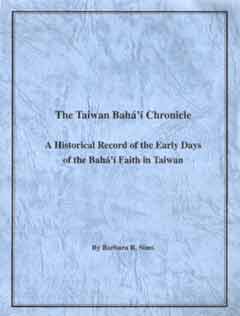 (click for larger) |
Copyright © Barbara R. Sims, 1994, Tokyo Digital text (with minor revisions) © 2001 by Barbara R. Sims and the Bahá'í Academics Resource Library All rights reserved |
Contents:
Introduction...........................................................................1
Chapter 1
The Beginning..........................................................................2
Chapter 2
Further Beginnings, Including the First Visit to Taiwan by a Hand of the Cause.........5
Chapter 3
The Nikko Conference in Japan and Mr. Khádem's Second Visit to Taiwan.................10
Chapter 4
The First Local Spiritual Assembly in Taiwan..........................................14
Chapter 5
A Letter Written on Behalf of the Guardian............................................16
Chapter 6
The First Teaching Conference in Taiwan...............................................17
Chapter 7
The First National Convention of the Bahá'ís of North East Asia, 1957.................18
Chapter 8
The Second Local Spiritual Assembly of the Bahá'ís of Tainan..........................20
Chapter 9
The First Bahá'í Summer School........................................................21
Chapter 10
Hand of the Cause Mr. Jalal Kházeh....................................................24
Chapter 11
The First Local Spiritual Assembly of Taipei..........................................25
Chapter 12
The Second Bahá'í Summer School.......................................................27
Chapter 13
The Third Bahá'í Summer School and Dedication of the Bahá'í Center in Tainan..........30
Chapter 14
The Early 1960s and Visits of Hands of the Cause Miss Alexander and Dr. Muhajir.......33
Chapter 15
The First Bahá'í Marriage in Taiwan...................................................37
Chapter 16
Bahá'í Literature in Chinese..........................................................38
Chapter 17
The Nine Year Plan, 1964-1973.........................................................40
Chapter 18
Appointment of the National Administration Committee and Further Advances.............44
Chapter 19
1966..................................................................................44
Chapter 20
Hand of the Cause Mr. Tarázu'lláh Samandari...........................................48
Chapter 21
The Hazíratu'l-Quds in Taipei.........................................................50
Chapter 22
The First and Second National Conventions of the Bahá'ís of Taiwan, 1967 and 1968.....51
Chapter 23
Some Events in the Later Years........................................................57
Names.................................................................................62
Afterword.............................................................................67
Bibliography..........................................................................69
|
the early Bahá'ís of Taiwan
that their endeavors on behalf of the Faith
shall not be forgotten
Chapter 1
Introduction
The population consists of indigenous islanders of Malay descent, islanders who arrived generations ago from the Chinese mainland, and mainlanders who settled in the late 1940s and early '50s. In 1965 (in the period relevant to this book) the population numbered about 11 million; currently it is over 21 million.
In 1895, at the end of the Sino-Japanese war, Taiwan was ceded to Japan, which held it until the end of the Second World War. In 1949 and over the next few years, following internecine struggles on the mainland, nearly two million refugees reached the island. Since then, Taiwan's largest city, Taipei, has been the seat of the government of the Republic of China, which comprises Taiwan and several smaller islands including the Pescadores.
2
1. The Beginning
 |
| (click for larger picture) |
Bahá'ís of Shanghai in the early 1930s. Standing left to right: Mr. S.A. Suleimani, Mr. Hossein Touty, Dr. Tsao Yan-siang, Mr. Husayn Ouskouli and his son Qudrat.
Seated left to right: Mrs. Ridvaniyyih Suleimani (one of Mr. Ouskouli's daughters), Mrs. Elin Tsao, Mr. OuskouIi's mother Sarah, and Mr. Ouskouli's other daughters, Ruhania and Jalalia.
3
The Suleimanis, originally from Iran, had lived for about 28 years in Shanghai where Mrs. Ridvaniyyih Suleimani's father, Mr. Husayn Ouskouli (Uskuli or Uskui), had long resided and conducted a business. In 1935 Mr. Ouskouli visited Taiwan, according to a letter he wrote to Shoghi Effendi from Shanghai. He was on a business trip to buy tea. He took some Bahá'í books in Chinese which he gave to a number of people, although the results are unknown. He was probably the first Bahá'í to set foot on the island.
Mr. and Mrs. Suleimani left Shanghai permanently in 1950 because of the difficult situation in China for foreigners. But Mr. Ouskouli decided to stay, earning the admiration of the Guardian. A letter to Mr. Ouskouli from the Guardian, written on his behalf by R. Rabbani, dated July 1, 1955, stated:
"Shoghi Effendi was very, very happy to hear from you after all these years, and to know that you are well, and still in Shanghai.
"He wants you to know that he admires your wonderful, selfless devotion to the Blessed Beauty, and the way you have remained in Shanghai, the land of your choice, through all the changes the years have brought. He also greatly admires your devoted daughter and son-in-law.
"He hopes you will keep in good health, and that you will keep with success in your work, and assures you of his prayers.
(In the Guardian's handwriting) "May the Almighty bless your highly meritorious efforts, guide and sustain you in your historic task, and enable you to enrich the record of your splendid services. Your true brother Shoghi."
Mr. Ouskouli died in Shanghai in 1956 at the age of eighty-two.
After leaving China, Mr. and Mrs. Suleimani first went back to Iran and then were able to make a pilgrimage to the Holy Land. The Guardian was urging people to attend the Fourth Intercontinental Conference in New Delhi in 1953 and the Suleimanis regarded it as a privilege to be able to attend. It was at that time, Mr. Suleimani wrote, that they were inspired to pioneer to Taiwan, a consolidation goal of the Ten Year Crusade. They arrived by ship in Keelung October 22, 1954.
4
 |
| (click for larger picture) |
This is thought to be the first Bahá'í pamphlet in the Chinese language. It was prepared and distributed by the Shanghai Bahá'ís in 1917.
Chapter 2
2. Further Beginnings, Including the First
Visit
to Taiwan By a Hand of the Cause
After the New Delhi Conference in 1953 the Hands of the Cause who attended the conference visited other areas to assist in the development of the Faith. In October of that year Mr. Zikrullah Khádem visited Taiwan, the first Hand of the Cause to do so. Mr. Jerome Chu (Chu Yao-lung) related that he had a meeting for Mr. Khádem at his home. As a result three people declared their belief in Bahá'u'lláh: Professor Tsao Li-shih, who was an instructor of architecture at Taiwan Engineering College; Mr. Hong Li-ming (Jimmy), the first native-born Taiwanese to become a Bahá'í; and Mr. Wong Ho-len (Wong Ho-jen). Mr. Khádem was the first Hand of the Cause to visit Macau during the same trip. He also went to Japan. During the time he was in Taiwan, Mr. and Mrs. Carl Scherer stopped over on their way to pioneer to Macau.
When Mr. and Mrs. Suleimani arrived in 1954 they found there was already a community of ten Chinese Bahá'ís, residing in various areas: in Taipei (2), Tainan (4), Tao-yuan, Tsoying and Chia-yi. Mr. Suleimani soon met eight of those Bahá'ís. He and his wife decided to settle in the southwestern city of Tainan where they rented a two-room apartment.
The first believer in Taiwan was Mr. Jerome Chu, a newspaper man, who had become a Bahá'í in Washington D.C. in 1945 after being taught by Mrs. Miriam Haney and Mr. and Mrs. Edwin Barham. Mr. Chu received a letter from the Guardian which ended with a message in his handwriting, "May the beloved bless your efforts, guide your steps, remove all obstacles from your path, and enable you to promote, effectively and under all conditions, the vital interests of His glorious Faith. Your true brother, Shoghi."
Mr. Chu, in a letter to Mr. and Mrs. Barham in 1953, wrote that the fireside meetings in the Barham' s apartment were the best times in his life. Mr. Chu had known Mr. and Mrs. Suleimani in Shanghai in 1949 and they kept in touch.
According to Mr. Suleimani, in 1949 the first four Chinese Bahá'ís arrived in Taiwan from the mainland to work as government employees. They were Mr. Chu, Maj. Chien Tien-lee (Maj. Lee L.T. Chang) who became a Bahá'í in the United States, and Mr. Mason Yuan (Yuan Mien-hsien) who became a Bahá'í through Mrs. Haney in 1947. Mr. Yuan told the Suleimanis, "Mother Haney taught me for a whole year every evening." He said that he had never felt such love and kindness. The fourth Bahá'í to arrive from the mainland was Mr. Yuan Hsu-chang,
6
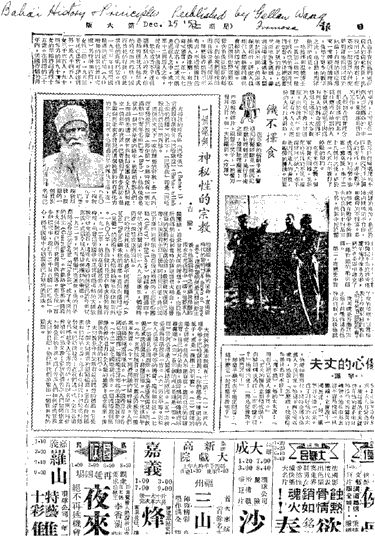 |
| (click for larger picture) |
On December 15, 1953 there was an article published in the Chung Hwa Daily News which had a photo of 'Abdu'l-Bahá and some history and principles of the Faith. This is no doubt the first publication about the Faith in a newspaper in Taiwan. The article was written by Mr. Gellan Wang.
7
There was another believer in Tainan, Mr. Gellan Wang (Wang Tzu-nan), who had become a Bahá'í in the United States in 1947. He worked in the Foreign Office in Taipei.
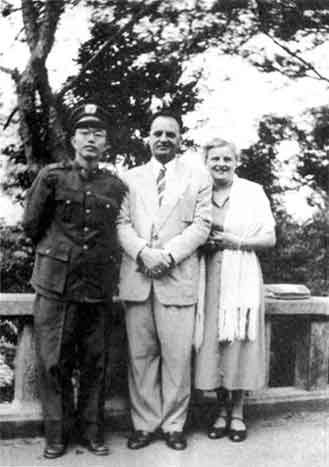 |
| (click for larger picture) |
Hand of the Cause Mr. Khádem on his first trip to Taiwan, November 17, 1953, with Lt. Col. Yuan Mien-hsien (Mason) and Mrs. Loretta Scherer. The Scherers stopped at Taiwan on their way to their pioneer post of Macau. Lt. Col. Yuan had become a Bahá'í in the United States in 1947.
8
The early Bahá'ís, including the three who came into the Faith through Mr. Khádem in 1953, were quite staunch and their names can be found in reports of activities in the early years.
Mr. and Mrs. Edwin Barham, described by Miss Agnes Alexander as being teachers of Mr. Chu and Mr. Wang, received a letter written on behalf of the Shoghi Effendi by R. Rabbani. It was dated July 28, 1954 and was sent to the Barham's home in Washington, D.C.
"Your welcome letter of June 21st with enclosures was received, and the beloved Guardian has instructed me to answer you on his behalf.
"He was delighted to learn of the excellent work Mr. Chu and Mr. Wang are
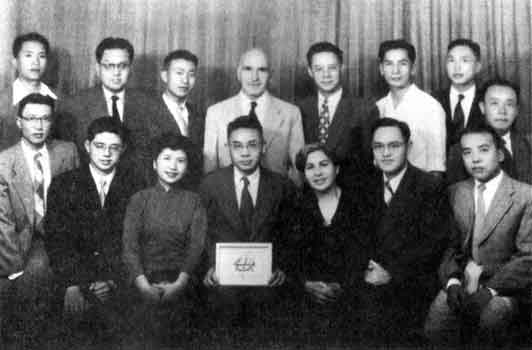 |
| (click for larger picture) |
Naw-Rúz Party at Tainan, 1955 Seated: Mr. Ho Cheng-tzu, Mr. Wong Ho-len, Mrs. Ruthy Tu, Mr. Jerome Chu, Mrs. Suleimani, Mr. Gellan Wang, Mr. Tsao Li-shih. Standing: Mr. Wang Chi-chang, Mr. Pai Chung-cheng, Mr. Tai Tung-ko, Mr. S.A. Suleimani, Mr. Liu H.Y. Mr. Luk Yun-shen (Winston), Mr. Cheng Chen-chang, Mr. Hsiao Tsan-chang (Johnson).
9
"When we realize what promise Formosa holds for the future, and that only a few years ago the Cause was unknown there, we can truly say miracles happen before our very eyes!
"The Guardian hopes you will be able to go to Formosa and help establish the projected assemblies there, and he urges you to keep in close touch with these two dear Bahá'ís. He is placing the newspaper article you forwarded in the Mansion Library at Bahji."
The Suleimanis started a study class as the Chinese felt they were not familiar with some aspects of the Faith. Several months later, on the evening of Naw-Rúz 1955, four people declared their Faith: Mr. Ho Cheng-tzu of Chia-yi, who several years later was to become the designer of the Tainan Bahá'í Center; Mr. Cheng Chen-chang of Taipei, who was in newspaper work; Mr. Pai Chung-cheng of Tainan; and Mr. Hsiao Tsan-chang (Johnson) of Chia-yi. Mr. Suleimani wrote that this was the most precious Naw-Rúz present bestowed on the island. This group was also quite active through the years.
In May 1955 Mr. Suleimani wrote that Capt. Shih Hung-mok, of Kangshan, declared his belief at Ridván. He was an active promoter of the Faith and helped with the printing.
At that time there were eighteen Bahá'ís in six localities, and it soon climbed to twenty-one believers.
In 1955 Mrs. Suleimani wrote a letter to Rúhiyyih Khánum and received a warm answer, quoted here in part, "Your most welcome letter of April 6 was received as well as the photographs you sent and I can assure you and your dear husband that the news you give of the progress of our Faith in Formosa has brought much joy to the heart of our beloved Guardian. I wish all the news he gets could make him as happy! ... it is only the good news — such as you send him — which lifts up his heart and enables him to carry on with his heavy tasks."
Chapter 3
3. The Nikko Conference in Japan and
Mr. Khádem's Second Visit to Taiwan
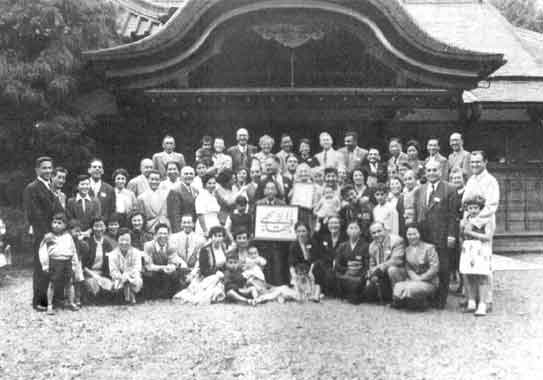 |
| (click for larger picture) |
The Nikko Conference, Nikko, Japan, 1955. It was the first International Teaching Conference in Asia. There were representatives from Japan, Hong Kong, Taiwan, Macau, Korea, Guam and the United States. Hand of the Cause Mr. Khádem, who was the Guardian's representative, is standing behind Mr. Fujita, who is holding the frame containing the "Greatest Name". Mr. and Mrs. Suleimani are standing together a little to the left; she is wearing a white dress. Hand of the Cause Miss Alexander is holding a picture of 'Abdu'l-Bahá. Mr. Harry Yim the only native-born Chinese able to attend the conference, is standing at the middle rear, between two women. Mr. Anthony Seto, the first Chinese-American Bahá'í and a pioneer to Hong Kong, is standing in the back row fourth from the right.
11
Mr. and Mrs. Suleimani had also attended the Nikko Conference representing Taiwan. Unfortunately no Chinese Bahá'ís from Taiwan were able to attend. However, Mr. Harry Yim went from Macau, the only Chinese Bahá'í to go. The Suleimanis brought with them a gift for the Japanese Bahá'ís: a lovely scroll painted in the Chinese style by Mr. Pai Chung-cheng. Soon after the Suleimanis returned to Taiwan they had another declaration, Mr. Luk Yun-shen (Winston), whom Mr. Suleimani described as being a native of Canton.

Mr. Suleimani is showing Mr. Yim from Macau a scroll painted by Mr. Pai Chung-cheng of Tainan, Taiwan. The scroll was a gift from Mr. Pai to the Bahá'ís of Japan.
12
 |
| (click for larger picture) |
Celebration of the anniversary of the Birthday of Bahá'u'lláh, 1955. Mr. Khádem is sitting at the end on the right. Mr. Suleimani is standing at the end behind Mrs. Ruthy Tu.
13
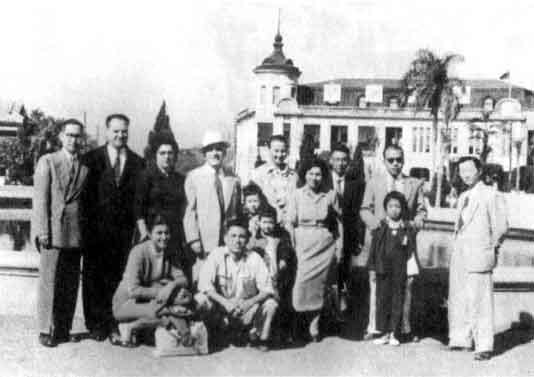 |
| (click for larger picture) |
The Tainan friends say goodbye to Mr. and Mrs. Khádem, standing second and third from the left, and Miss Haddad kneeling in front of them. This photo was taken at the Tainan Railway Station.
Chapter 4
4. The First Local Spiritual Assembly in Taiwan
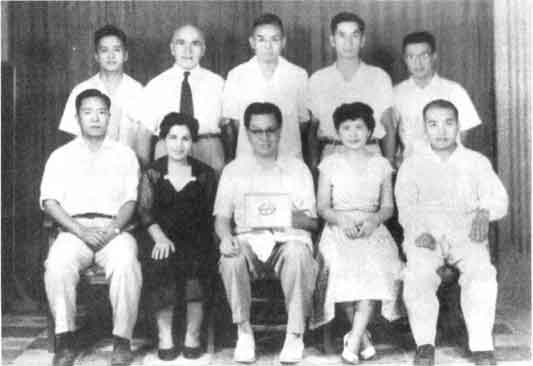 |
| (click for larger picture) |
The first Local Spiritual Assembly of the Bahá'ís of Tainan, Taiwan, April 21, 1956. Nine of the ten Bahá'ís shown in the photo constituted the first Local Spiritual Assembly in Tainan. As nearly as we can deduce the following identification is correct.
Seated: Mr. Wang Chi-chang, Mrs. Suleimani, Mr. Pai Chung-chen, Mrs. Ruthy Tu, Mr. Tsao Li-shih. Standing. Dr. Ni Jun-chung (ching), Mr. Suleimani, Mr. Chu, Mr. Winston Luk, Mr. Ho Chung-tzu.
We knew there must be a reason for submitting a photo of the Local Spiritual Assembly with ten people instead of nine.
We discovered that as there were ten Bahá'ís in the community they held an election but could not break the tie among all ten. However, they had been asked to submit a photo to the American Bahá'í News of their Local Spiritual Assembly as it was one which would participate in the election of the National Spiritual Assembly of the Bahá'ís of North East Asia the following year.
They finally wrote to the Asia Teaching Committee of the United States about the problem. That committee suggested that they draw ten slips of paper; one being blank. Mr. Suleimani drew the blank slip, but by the next year Dr. Ni was off and the other nine were elected.
15
Mrs. Tu died in 1969. When Mr. Suleimani visited her in the hospital he wrote that she was very weak but "still perfect in spirit and mind." About twenty years later her daughter accepted the Faith.
Chapter 5
5. A Letter Written on Behalf of the Guardian
 |
| (click for larger picture) |
Chapter 6
6. The First Teaching Conference in Taiwan
Miss Alexander visited Taiwan three times. The second visit was in 1958 and the third in 1962. The latter two times her visits were as a Hand of the Cause.
 |
| (click for larger picture) |
The first All-Taiwan Teaching Conference, held in Tainan, November 11 and 12, 1956. Miss Alexander (center), who at that time was an Auxiliary Board Member, attended from Japan. It was her first trip to Taiwan. She stayed for three weeks to help with the teaching.
Chapter 7
7. The First National Convention
of the Bahá'ís of North East Asia, 1957
"This auspicious event, which posterity will regard as the culmination of a process initiated, half a century ago, in the capital city of Japan ... marks the opening of the second chapter in the history of the evolution of His Faith in the North Pacific area. Such a consummation cannot fail to lend a tremendous impetus to its onward march in the entire Pacific Ocean..."
The names of Sakhalin Island and Hainan Island were dropped from the jurisdiction of the National Assembly as it was not possible to travel or teach in those places. However, both remained goals of the National Assembly to open to the Faith. In 1959 Mr. John Chang, a resident of Macau, went to Hainan for two weeks, thereby becoming a Knight of Bahá'u'lláh for opening that area. Sakhalin was opened in 1990.
A letter written on behalf of the Guardian shortly before the Convention stated, "The Guardian is looking forward with keen anticipation to the forthcoming Ridván period, as it marks the establishment of thirteen new National Assemblies; the most important of which are in the Pacific area..."
Mrs. Ruthy Tu had been elected as a delegate from Tainan to the convention but unfortunately she was unable to attend. As Mr. and Mrs. Suleimani attended, Taiwan was represented.
19
 |
| (click for larger picture) |
Chapter 8
8. The Second Local Spiritual Assembly
of the Bahá'ís of Tainan
According to an annual report sent for 1957/58 to the parent assembly in Tokyo, the Tainan Assembly was very active. For example it met regularly, had study classes twice a week, public meetings every Sunday, conducted a once-a-week fireside and on Saturday night had a dinner party. All of these activities were held in the Bahá'í Center. Mrs. Tu also had her own study class. The Suleimanis made forty-two teaching trips that year to Taipei, Tsoying and Chia-yi. Mr. Wong Hou-len had a study class at his residence in Tsoying, and the Tainan Bahá'ís helped.
During 1957 the National Spiritual Assembly of North East Asia appointed Mr. Jerome Chu and Professor Tsao Li-shih to the Translation Committee of Taiwan. Their first project was to revise and print one thousand copies of a pamphlet in Chinese which had originally been translated by the Chinese Bahá'ís in Kuching, Borneo (now Sarawak), and printed there. However, Mr. Chu assured the National Assembly the essence of the original pamphlet had not been changed.
Chapter 9
9. The First Bahá'í Summer School
The Bahá'ís were so inspired by the summer school that they sent a cable to the Guardian. He replied, "Deeply appreciate message assure attendants fervent prayers success deliberations deepest love Shoghi."
 |
| (click for larger picture) |
The first Bahá'í Summer School in Taiwan was held September 28-30, 1957 in Tainan at the Eastern Garden Hotel.
In the first row at the right are Mr. Suleimani and Auxiliary Board Member from Macau Mr. Carl Scherer. Behind him is Mr. Philip Marangella representing the National Spiritual Assembly of North East Asia. Mrs. Suleimani is standing next to him.
22
There were several letters back and forth between the Tainan Local Spiritual Assembly and the National Spiritual Assembly of North East Asia in Tokyo concerning this great loss. The Tainan Local Spiritual Assembly, in addition to having special prayer meetings after being informed of the tragic situation, arranged for memorial services in Tainan, Taipei and Tsoying. One of the believers in Chia-yi, Mr. Huang, joined the Tainan memorial services and took back the spirit to the other Bahá'í who couldn't attend. The memorial services included prayers in three languages and the reading of a description of the Guardian's first twenty-five years as written by Amatu'l-Bahá Rúhiyyih Khánum in The Bahá'í World, Vol. XI.
The Taiwan community sent a cable of condolence to Rúhiyyih Khánum which she answered saying that she deeply appreciated their message.
23
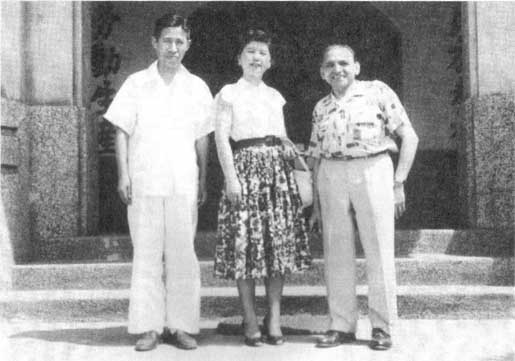
Following the first Summer School, Mr. Marangella accompanied by Mrs. Tu visited the Pescadores. They are shown here introducing the Faith to Mr. Fan, principal of a government school at Mahkong.
Chapter 10
10. Hand of the Cause Mr. Jalál Kházeh
A Certificate of Registration was granted to the National Spiritual Assembly December 8,1970.
 |
| (click for larger picture) |
Chapter 11
11. The First Local Spiritual Assembly of Taipei
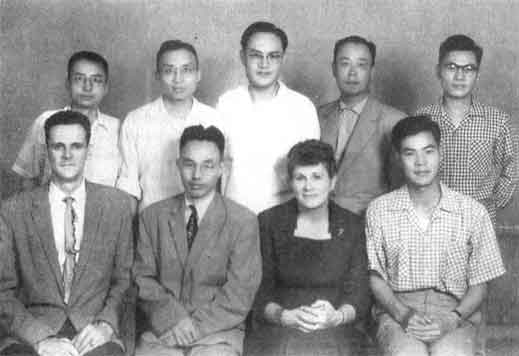 |
| (click for larger picture) |
The first Local Spiritual Assembly of the Bahá'ís of Taipei, 1958 We can identify the following. Seated from the left: Mr. Keith Craig, Mr. Yuan Mein-shien (Mason) and Mrs. Edith Danielsen-Craig. Standing: second from the left Mr. Yuan Hsu-chang, Mr. Gellan Wang, Mr. Hsiao Tsan-chang (Johnson) and Mr. Hong Lee-ming (Jimmie). We have ascertained that the top far left and bottom far right are Mr. Pershing Wang and Mr. Shih Hung-mok but we do not know which is which.
26
In Taipei there was much activity after the arrival of the Danielsen-Craigs. They stayed for three years until 1961, devoting all energies to the advancement of the Faith. In 1960 Mrs. Danielsen-Craig wrote about the first youth to enroll, Wang P'u-sheng (Steven), brother of Pershing Wang. She said he was a quiet, thoughtful boy who was "filled with the love of Bahá'u'lláh."
In 1959, due to a change in the administrative area, which had the effect of removing some of the Bahá'ís from the city limits, the Local Spiritual Assembly was not able to form. Nor could it the year after. In 1961 things had progressed to a point where the Bahá'ís could elect an assembly, but not the year after that.
In 1963 assisted by the arrival of pioneers Mr. and Mrs. Enger, they were able to elect the assembly but its status was lost the following year. Then in 1965 an assembly was elected and that status has continued. Taipei had steady enrollments but much of the problem stemmed from the fact that the active Bahá'ís tended to move out; many left Taiwan to continue their studies in the U.S. But then many of the Bahá'ís were quite internationally minded so it is not surprising that they would try to advance their education by moving to another country.
Tainan also had a moving population of Bahá'ís but always managed to elect the local assembly, from 1956 on. Much of this was undoubtedly due to the steadfastness and stability of Mr. and Mrs. Suleimani. They were always there, teaching, deepening, making new friends, from the beginning in 1954 to the end of their lives.
Chapter 12
12. The Second Bahá'í Summer School
Hand of the Cause Miss Alexander and Auxiliary Board Member from Macau, Mr. Scherer, attended. Miss Alexander spoke on the timely subject of the Will and Testament of 'Abdu'l-Bahá and the Guardianship.
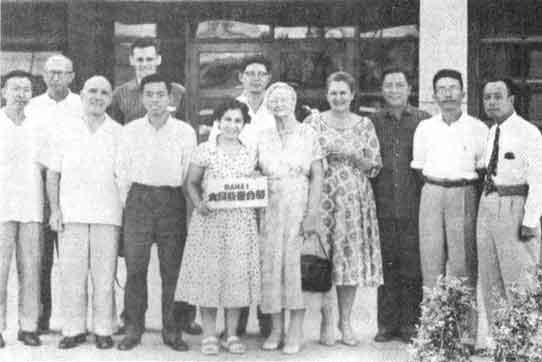 |
| (click for larger picture) |
The Second Taiwan Summer School was held in Taipei, October 10-12, 1958 at the International House. Thirty-three people attended, including Hand of the Cause Miss Agnes Alexander from Japan.
The photo shows only some of the Bahá'ís who attended. Auxiliary Board Member Carl Scherer from Macau is standing at the left. Mr. Suleimani is next to him. Behind him is Mr. Keith Danielsen-Craig. Mrs. Suleimani is holding the plaque and Miss Alexander is standing next to her. Mrs. Danielsen-Craig is next. Unfortunately, the other friends are unidentified.
28
The Faith was slowly growing. By April 1958 the number of Bahá'ís in Taiwan had increased to twenty-two representing five localities, Tainan, Taipei, Tsoying, Hsin-ying and Chia-yi.
 |
| (click for larger picture) |
Mrs. Danielsen-Craig conducted a youth study class three nights a week in Taipei (1958). Three of the young people (two girls and one boy) were children of a Bahá'í. Two young men were brothers of a Bahá'í.
29
 |
| (click for larger picture) |
Chapter 13
13. The Third Bahá'í Summer
School and
Dedication of the New Bahá'í Center in Tainan
From Japan came Mrs. Joy Earl and Mr. and Mrs. Noureddin Mumtazi. Mrs. Earl acted as chairman of the Summer School. Of course, the four pioneers to Taiwan, Mrs. and Mrs. Suleimani and Mr. and Mrs. Danielsen-Craig attended.
The highlight of the program was the dedication of the new Center, which was designed by Mr. Ho Chung-tzu and supervised by Mr. Wang Chi-chang. Mr. Suleimani wrote that Mr. Pai Chung-cheng introduced him to the land owner and that Mr. Chung Yin-ching (a non-Bahá'í) helped legally with the purchase of the
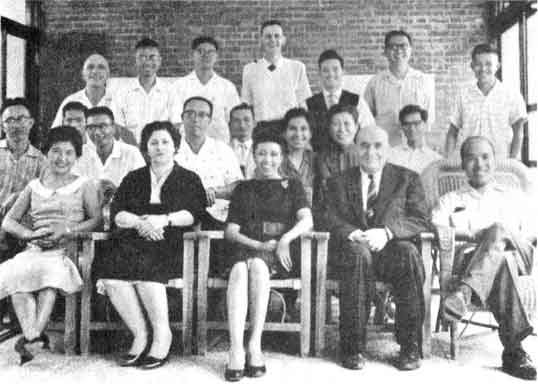 |
| (click for larger picture) |
Some of the participants of the third Taiwan Summer School, October 10 to 12, 1959.
Middle of front row: Mrs. Behjat Mumtazi, Mrs. Joy Earl and Mr. Noureddin Mumtazi attended from Japan.
31
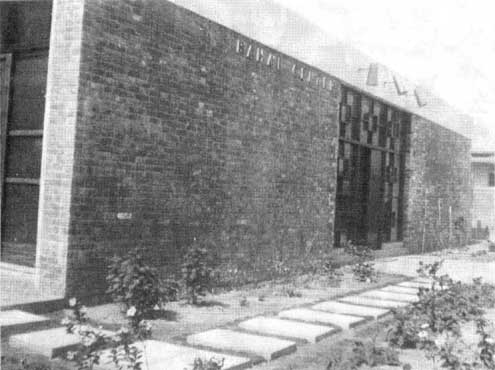
The main event of the Summer School was the dedication of the Bahá'í Center in Tainan.
Top photo: the main entrance. Bottom photo: part of the main hall.

32
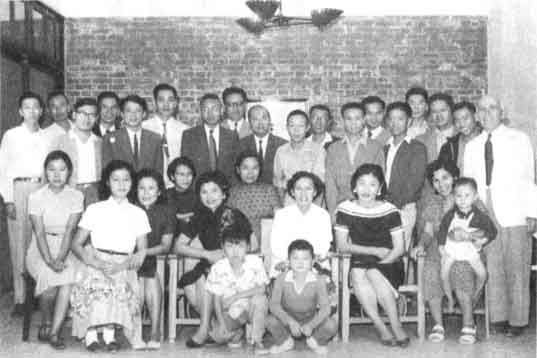 |
| (click for larger picture) |
Celebration of the Anniversary of the Birth of Bahá'u'lláh, November 12, 1959. Mr. and Mrs. Suleimani are at the right. We can see some of the early Taiwan Bahá'ís standing at the rear.
Chapter 14
14. The Early 1960s and Visits of
Hands of the Cause
Miss Alexander and Dr. Muhajir
After the Summer School there was enough interest for Taipei to establish a youth group.
Travel teacher Muhammad Labib visited in 1961, with his daughter Lily, and he was successful in teaching as he was everywhere he went, causing the Local Spiritual Assembly of Taipei to write to the National Spiritual Assembly of North East Asia to send another such pioneer to Taipei. Mr. Labib, who was originally a pioneer to Japan, visited Hong Kong as well as Taiwan, but he had visa problems and could not stay for any length of time.
In 1961 Mr. Suleimani sent a list of Bahá'ís in the southern area. There were thirteen adults in Tainan, which included three women, Mrs. Tu, Mrs. Suleimani
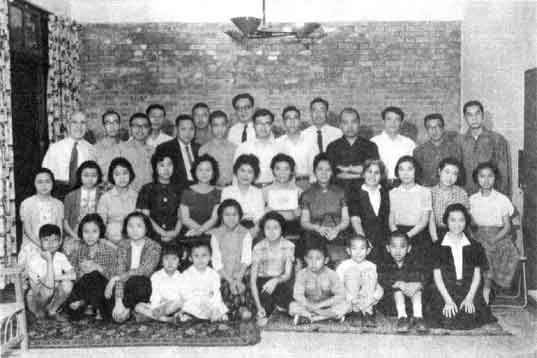 |
| (click for larger picture) |
The Tainan Bahá'ís and their friends celebrate Naw-Rúz 1961. Especially satisfying was to see so many young people. Mrs. Kao (Yang Su-su), newly declared, is holding the "Greatest Name".
34
In 1962 Hand of the Cause Miss Alexander visited Taiwan for the third time. Of that trip she wrote, "When we reached the Center in Tainan I could not get over my delight at the lovely Center with flowers surrounding it. I was there for eleven days, each day full. I came to know the Taiwanese people and truly loved them. Now there are quite a number of Bahá'ís in Tainan, five in one family (the Yang family) declared their faith at the same time. The last evening I met the parents for whom I felt a great love. As they were in the country under the Japanese they know the language so we could speak together. They are not Bahá'ís but their children are.
Mr. Suleimani wrote that Miss Alexander's visit was a source of inspiration to all the friends and it culminated in one declaration, Mr. Wu Pin-chen of Pingtung,
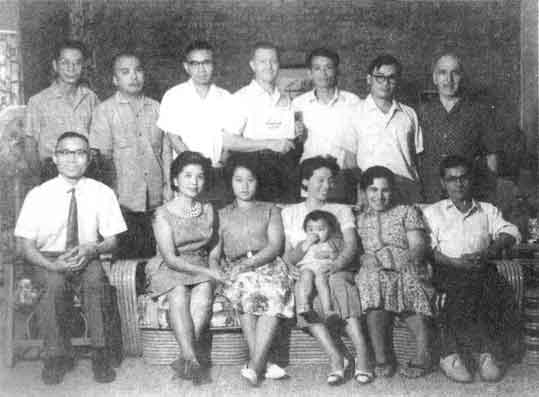 |
| (click for larger picture) |
This photo was taken on the occasion of the Anniversary of the Birth of the Báb, October 20, 1962, at the Tainan Bahá'í Center.
Mr. Suleimani is standing at the far right. Dr. David Earl is standing in the center. Mrs. Ruthy Tu is sitting second from the left and Mrs. Suleimani is sitting second from the right.
35
Later that year one of the daughters of Mr. and Mrs. Yang, a middle school student, spoke at a picnic gathering for young people at the Bahá'í Center in Tainan. About thirty people were present to hear her speak of the history and principles of the Faith.
In April, 1962, there were one Assembly, three groups and six isolated centers. The Local Assembly of Taipei could not be formed that year due to too few members and so became a group.
With the arrival of American pioneers Dale and Barbara Enger in August 1962 activity increased in Taipei, where they settled.
Dr. Muhajir first came to Taiwan in February 1963. The next year, 1964, he came twice and in 1966 twice. He continued to visit Taiwan, for how many times it is difficult to determine. During his second trip he had meetings with the friends
 |
| (click for larger picture) |
Hand of the Cause Dr. Muhajir (standing fifth from the left) during his second visit to Taiwan, March 1964. This photo was taken at the Bahá'í Center in Tainan.
36
In April 1963 the Bahá'ís in Taiwan attempted an extensive proclamation in connection with the 100th Anniversary of the Proclamation of Bahá'u'lláh. From London, which was the site of the first World Congress, press releases were sent which were translated into Chinese and were given to all newspapers and radio stations, resulting in several newspapers publishing the information and two radio stations broadcasting it. Mr. Suleimani said it was the first time such a wide proclamation was attempted. There was a well-attended Proclamation celebration at the Tainan Bahá'í Center.
In Taipei, at the same time, there was a meeting which was reported to have had "good coverage in the Chinese newspapers."
Two days after the meeting, on April 23, the Suleimanis and Mr. Chu left Taiwan to attend the first World Congress in London. It appears that Mr. Chu might have been the only native-born Chinese to attend the Congress, although at least one Chinese-Singaporean and some Chinese-American Bahá'ís also attended.
In November 1963 two Summer Schools were held, one in Taipei and one in Tainan. The classes were conducted by the resident Bahá'ís.
One of the goals of the Ten Year Plan for India was to translate Bahá'í literature into several Chinese languages. The National Spiritual Assembly of India wrote to the National Spiritual Assembly of North East Asia asking for assistance. That Assembly then contacted the Local Spiritual Assembly of Tainan asking if they could find a way to translate any of the languages. That Assembly found a professor in a Foreign Language University who knew Mongolian (one of the languages specified), and he was able to translate The Bahá'í Message, writing it in Mongolian script, so it was ready for photo offset printing. It happened to be ready in February 1963 at a time when Dr. Muhajir was in Taiwan. As he intended to go on to India he suggested that he take it and deliver it in person to the Publishing Trust of India.
Chapter 15
15. The First Bahá'í Marriage in Taiwan
Official government recognition of the Bahá'í marriage was obtained in 1973.
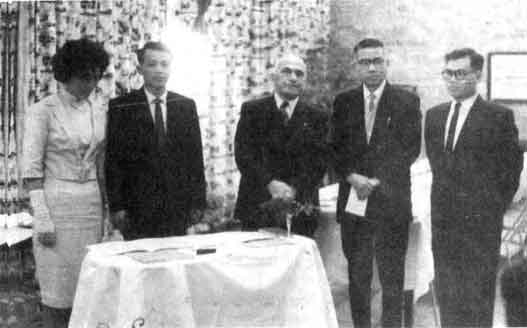 |
| (click for larger picture) |
The bride, Miss Yeh Chon-ching and the groom Mr. Yang Su-thou are standing to the left. Mr. Suleimani in the middle, Mr. Jerome Chu (officiating) and Mr. Kao Ching-seng. Mr. Suleimani and Mr. Kao were witnesses from the Local Spiritual Assembly of Tainan. Prayers were said in four languages.
Mr. Yang was active in the National Teaching Committee of Taiwan and was a member of the Tainan Local Spiritual Assembly for some years in the early 1960s.
Chapter 16
16. Bahá'í Literature in Chinese
As the Faith progressed it became increasingly important and necessary to have literature in Chinese. With this in mind, in 1958 the National Assembly appointed a Translation and Reviewing Committee. Mrs. Danielsen-Craig was secretary of the committee, and although she couldn't speak Chinese she was instrumental in getting the work done. Within two or three years several pamphlets and books were produced.
The basic pamphlet first printed in Kuching was revised and reprinted in 1957. Mr. Chu, who did this revision, worked on the committee for several years after it was appointed.
Bahá'u'lláh and the New Era was revised and reprinted in 1960. The committee printed 500 and gave one copy to every Bahá'í in Taiwan. They had about sixty left which were immediately ordered by other countries in South East Asia. It was decided to print an additional 1,000, realizing how great the need was for literature in Chinese. A new prayer book was printed in 1961 using prayers from the one printed in Macau and adding some. The smaller one was also available.
By 1962 there were five basic pamphlets available in Chinese in Taiwan, translated from ones in English: The Bahá'í Faith, Bahá'í Answers, Basic Facts of the Bahá'í Faith, The Keystone, Bahá'í Teacher's Manual.
The old version of Paris Talks by 'Abdu'l-Bahá was revised and 1,000 reprinted in 1963. It was printed again, 2,000 copies, in 1966. The New Garden was a new translation done by Mr. Tsao Li-shih printed in 1965. Also in 1965 another pamphlet, One Universal Faith was printed, 1000 copies. It was a good beginning.
The Taiwan Bahá'í Publishing Trust was established in 1972, The number of books and the attractive quality of the printing is now well-known.
39
 |
| (click for larger picture) |
Some of the early pamphlets printed in Taiwan available by 1962. Bahá'í Answers (lower left) was translated in 1958 by Mr. Mason Yuan (Yuan Hien-hsien) who became a Bahá'í after being taught by Mrs. Miriam (Mother) Haney in Washington D.C. many years earlier. That pamphlet of 2500 copies was financed by the Taipei pioneers.
Chapter 17
17. The Nine Year Plan, 1964 -1973
When the National Spiritual Assembly of Taiwan was elected in 1967, the unaccomplished goals were passed on to the new Assembly, and more were included. They did eventually accomplish all the goals of the Nine Year Plan.
In 1964 statistics given out for Taiwan were: two Local Spiritual Assemblies and seven groups.
1965 started out auspiciously with the enrollment of Miss Hung Bao-fung, who was a friend of Miss Jean Cheng. Miss Hung was the first declared believer in Kaohsiung according to Mr. Suleimani.
A report was sent to the National Assembly in Tokyo in April of that year stating that the Taiwan Bahá'í community now consisted of about one hundred believers residing in 25 localities; a considerable advance over the previous year.
Teaching Conferences and Summer Schools seem to have been held every year since they began in 1956 and 1957 respectively. In 1965 a Summer School was held in both Tainan and Hualien for the convenience of the friends. There were many new Bahá'ís in Hualien who needed deepening.
Chapter 18
18. Appointment of the National Administrative
Committee and Further Advances
During 1965 teaching seemed to pick up considerably. Many youth came into the Faith that summer. According to some of the reports received during the month of April there were ten youth and six adult enrollments; in May eleven youth and four adults; in June thirty-eight youth and thirty-nine adults; in July twenty-nine youth and thirty-five adults; in August twelve youth and twenty-eight adults. The pace kept up. From April 1965 to April 1966 enrollments reached more than four hundred; about half youth and half adults. There were still two Local Spiritual Assemblies, twenty-six groups, and thirteen isolated localities, a total of forty-one localities. Mr. John Huston and Mrs. Orpha Daugherty took the Faith to two indigenous tribes, the Ami and the Taroko, resulting in many declarations.
Part of this expansion was due to more pioneers such as Mr. Huston, who spoke Chinese, and Mr. Charles Duncan, who the previous year had been appointed Auxiliary Board Member by Hand of the Cause Miss Alexander. Mr. Duncan was a Knight of Bahá'u'lláh for first pioneering to Brunei in 1954. Auxiliary Board Member Orpha Daugherty, a pioneer to the Philippines, also came to Taiwan to help with the teaching. Mrs. Daugherty was a warm, caring person who pioneered successfully in several countries in Asia. It is recorded that she gave a talk at International House for the Naw-Rúz Celebration, with fifty people attending. It had been announced in the English-language newspaper. In July of that year Mr. G.V. Tehrani, pioneer to Japan, visited Taiwan for three weeks, going to seven different places for teaching.
Mrs. Abbie Maag moved to Taipei that year. Mr. and Mrs. Dale Enger pioneered in Taiwan 1963/1964; Dr. and Mrs. Sidney Dean 1966/1967; Mrs. Mehri Molin helped the community very much from 1968 on. There were also others. Mr. Duncan said the sudden expansion of the Faith could not have happened but for the willingness of the Chinese Bahá'ís to go with the pioneers and translate for them. The
42
Mr. Yankee Leong, the first Bahá'í in Malaysia, and Auxiliary Board Member Mr. Leong Tat Chee from Malaysia came to Taiwan in 1965. They could only stay two weeks due to visa problems. They were to come back in the future with great results.
In October 1965 Dr. Muhajir met with the National Administrative Committee and talked about teaching, deepening, gifts of books to schools, libraries and prisons, putting ads in the newspapers, and having correspondence courses. The committee made plans to go ahead with his ideas.

Mr. Yankee Leong, Miss Len Yuk Hua and Mr. Charles Duncan. Miss Len was a dancer belonging to the Ami tribe. She had just accepted the Faith. The photo was taken in Hualien, summer of 1966.
43
In October of that year a memorial service was held in Taipei for Mr. Jason Yeh (Yeh Chin-hsing), the first Bahá'í to die in Taiwan.
Mr. Duncan wrote an account of Mr. Yeh's illness in an Auxiliary Board Member report to Hand of the Cause Miss Alexander. With Mr. Duncan's permission we are repeating it here.
Mr. Duncan received a telephone call from Mrs. Liu, a non-Bahá'í friend of John Huston. Mr. Huston was not in town so she spoke to Mr. Duncan. She said she and her husband had a friend, Mr. Yeh, who had kidney cancer and was not expected to live more than a few weeks. He was worried about the condition of his soul after death. He had studied Christianity but thought it was too exclusive. He did not believe in the superstitions of Buddhism so Mrs. Liu told him about the Bahá'í Faith although she herself had not become a Bahá'í. Mr. Yeh wanted to know more about the Faith and that was why she had telephoned.
Mr. Duncan visited Mr. Yeh every day. On the second day Mr. Yeh signed his enrollment card. The next day his wife became a Bahá'í and two days later, his brother declared. Mr. Yeh's wife said to Mrs. Liu, "We have always been such good friends and have done everything together but now something is separating us. Why don't you become a Bahá'í?" The next day Mrs. Liu declared her Faith and started telling her friends about it.
Mr. Duncan said he often recited the long Healing Prayer for Mr. Yeh. Mr. Yeh was assured of life to come and although he had some fears about dying, he was greatly comforted. He died a few weeks later.
Chapter 19
19. 1966
That year, in October, the Trustee of the Huqúqu'lláh. Hand of the Cause Mr. Varqá, appointed Mr. Suleimani as the representative of the Trustee for the Huqúqu'lláh in the Far East and the Pacific. The Law of Huqúqu'lláh was not generally applied at that time, but according to Mr. Varqá there were some among the Persians who observed it.
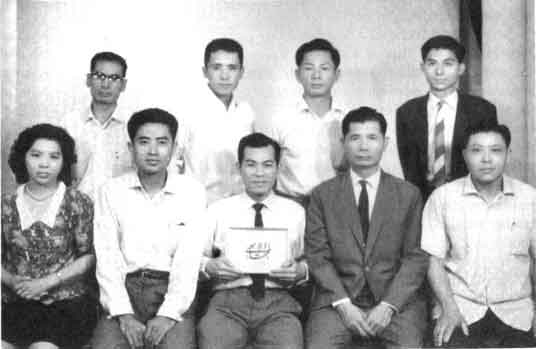 |
| (click for larger picture) |
The Local Spiritual Assemblies of Pingtung and Hualien, elected in 1966, were the third and fourth Local Assemblies to be elected in Taiwan. Shown here is the first Local Spiritual Assembly of the Bahá'ís of Pingtung.
Seated: Mrs. Wu Ping-chen, Mr. Chung Ching-tan, Mr. Wu Ping-chen, Mr. Wu Wen-jen, and Mr. Lee Liang-tung. Standing. Mr. Wang Ching-ian, Mr. Chiu Chung-shao, Mr. Huang Hai-tan and Mr. Wen Lung-fui.
45
He visited Taiwan at other times, also. In 1972 during a visit he presented Bahá'í literature to Mr. Henry Kao, Mayor of Taipei.
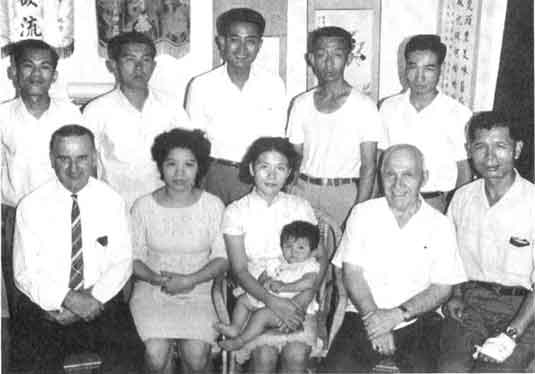 |
| (click for larger picture) |
46
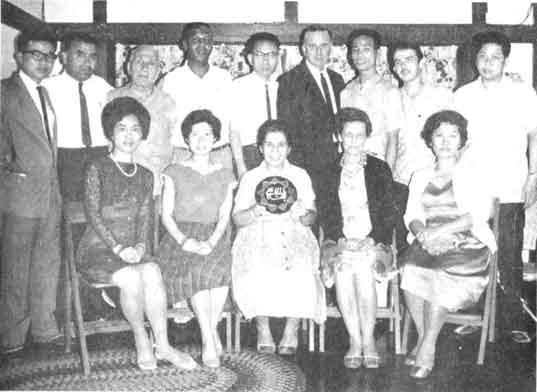 |
| (click for larger picture) |
Hand of the Cause Mr. Featherstone in Taipei in 1966. Seated: in the middle, Mrs. Suleimani, next to her is Mrs. Abbie Maag, who was pioneering in Taipei. Standing: second from the left is Dr. Soraya who was an Auxiliary Board Member from Indonesia, Mr. Suleimani and Auxiliary Board Member Mr. Charles Duncan. Mr. Featherstone is fourth from the right and Mr. John Huston is second from the right. Unfortunately we cannot identify the Chinese friends.
47
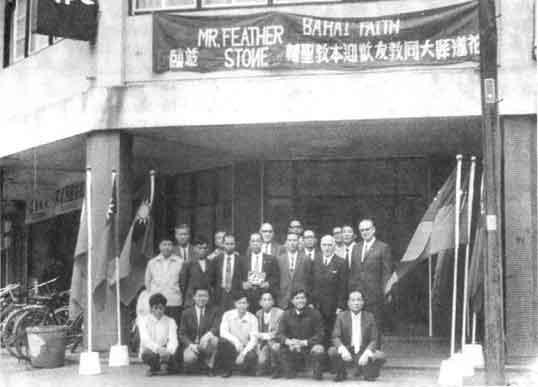 |
| (click for larger picture) |
This picture of Mr. Featherstone, standing far right, and other friends, was probably taken in 1972 when he visited Hualien.
Chapter 20
20. Hand of the Cause
Mr. Tarázu'lláh Samandari
One of the problems in Taiwan was the Chinese written characters used for the word "Bahá'í" and other words associated with the Faith. During meetings with Mr. Samandari the National Administrative Committee came to some permanent solutions to the problem.
Frequent meetings with the friends were scheduled for Mr. Samandari, including one in Mr. Mark Lin's (Lin Fang-nan) house in Hsing-Tien. The Hand of the
 |
| (click for larger picture) |
49
Back in Taipei a public meeting was held for Mr. Samandari with forty people attending. He spoke on the necessity of Divine Education. Then to Hualien, where he met with members of the Local Spiritual Assembly. He left for Hong Kong on the 11th of November.
The Bahá'ís in Taiwan felt that the visit of Mr. Samandari created a new spirit and that the friends would serve the Cause of God with renewed dedication.
Chapter 21
21. The Háziratu'l-Quds in Taipei
At the encouragement of Dr. Muhajir the Bahá'ís of Taipei found a suitable site. It was an apartment on the third floor of a new building in a good location. The purchase price was US$9,000, which was a considerable sum in those days. The National Spiritual Assembly of the United States paid US$6,000 and the rest came from the National Spiritual Assembly of North East Asia and donations. It was bought in time to hold the Naw-Rúz celebration there in 1967. The first National Convention, the same year, was held in it.
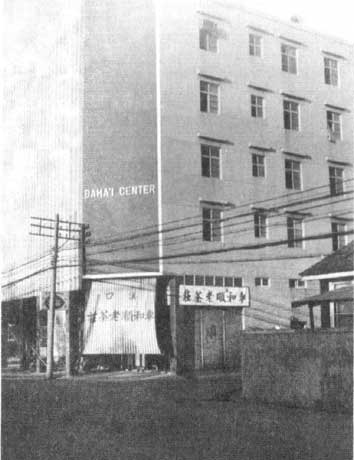
The National Hazíratu'l-Quds in Taipei is on the third floor of this building. This photo was taken not long after its purchase in 1967.
Chapter 22
22. The First and Second National
Conventions
of the Bahá'ís of Taiwan, 1967 and 1968
Dr. Muhajir was not able to leave the Philippines in time to attend the convention so he asked Auxiliary Board Member Mr. K. Payman from Indonesia to attend in his place.
The convention was also attended by representatives from the National Spiritual Assembly of the Bahá'ís of North East Asia: Mr. Philip Marangella, Mrs. Barbara Sims, Mr. Hideya Suzuki and Mr. Hiroshi Yamazaki. Auxiliary Board Members Mr. Rouhollah Mumtazi and Mr. Charles Duncan also attended.
The four Local Spiritual Assemblies that had delegates assigned were Taipei (7), Tainan (6), Hualien (4), and Pingtung (2), making a total of nineteen delegates. Eighteen ballots were cast. Twelve delegates were present and six ballots were received by mail. It was recorded that there were about 500 Bahá'ís in Taiwan at that time.
The members of the first National Spiritual Assembly of the Bahá'ís of Taiwan were Mr. Robert Yen, Mr. Kuo Rong-hui, Dr. Sidney Dean, Mrs. Isabel Dean, Mr. Tsao Kai-min, Mr. Huang Tsen-min, Mr. S.A. Suleimani, Mrs. Ridvaniyyih Suleimani and Mr. Huang Ting-sheng.
The Universal House of Justice sent a special message to the new National Spiritual Assembly, giving them several new goals. Some of the goals were left over from the original Nine Year Plan, but many of the new goals were for a larger and more consolidated community which Taiwan had become. For example, they were to raise the number of localities where Bahá'ís reside to one hundred; raise the number of Local Spiritual Assemblies to twenty; establish a Teaching Institute with the assistance of the National Spiritual Assembly of Malaysia; and to extend teaching among the aboriginal people. Another goal was to acquire a site on which to build the future Mashriqu'l-Adhkár. The land was purchased in 1972 and recorded in 1978; 9920 sq. mtrs. in the town of Lin Kou, near Taipei. Another piece of land was purchased in Lin Kou which counted as an Endowment, the acquisition of which was also a goal.
That fall it was necessary to have two by-elections. The first by-election was due to the resignations of Mr. Tsao Kai-min and Mr. Huang Ting-sheng. Their replacements were Mr. Kit Yin-kiang and Mr. Lin Yi-mou.
52
Dr. and Mrs. Dean left Taiwan that fall. There appears to have been one or two more by-elections with the final result of Mrs. Elizabeth Yen and Mr. Shan Yi-chian being elected to the National Assembly for that year.
In November 1967 Mr. Suleimani wrote to the secretary of the National Spiritual Assembly of North East Asia, Mrs. Sims, that they had a successful celebration of the 150th Anniversary of the Birth of Bahá'u'lláh in both Taipei and Tainan. This was a joint effort of the Taipei and Tainan communities. Three hundred invitations were sent out and one hundred people attended. A brief announcement was made by Tainan Victory Radio and the Taiwan Daily News. It was a joyous event.
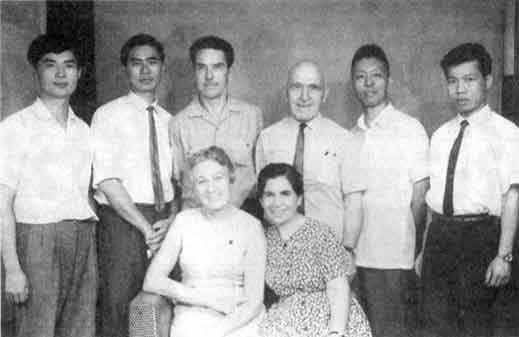 |
| (click for larger picture) |
The First National Spiritual Assembly of the Bahá'ís of Taiwan, 1967. Sitting: Mrs. Isabel Dean and Mrs. Ridvaniyyih Suleimani. Standing: Mr. Kuo Rong-hui, Mr. Robert Yen, Dr. Sidney Dean, Mr. S.A. Suleimani, Mr. Tsao Kai-min and Mr. Huang Tsen-min. Missing member is Mr. Huang Ting-seng.
53
That month Hand of the Cause Mr. A.Q. Faizi paid a brief visit to Taiwan. Later in a letter he wrote to the friends in Taiwan, he mentioned his appreciation of the Bahá'í community, especially Mr. Chu, who translated for him. He also wrote that he would never forget the smiling face of Mr. Kit and praised him for pioneering to Taiwan from Malaysia.
Mr. Suleimani reported that at the second Annual Convention, 1968, elected to the National Assembly were three Chinese (Mr. Lin Yi-mou, Mr. Yu Hsih-ho and Mr. Huang Ting-sheng), one American (Mr. John Huston), one Briton (Mrs. Elizabeth Yen), one Chinese-Malaysian (Mr. Kit Yin-kiang) and three Iranians (Mr. and Mrs. Suleimani and Mrs. Mehri Molin). The backgrounds were quite different
 |
| (click for larger picture) |
The first National Convention of the Bahá'ís of Taiwan, 1967, was attended by several members of the National Spiritual Assembly of the Bahá'ís of North East Asia and by Auxiliary Board Member Mr. K. Payman. Front row from the left: Mr. Lin Yi-mou, Mr. Loren Dzen, Mr. Peng Fu-fa, Mr. Yu Hsih-ho, Mr. Charles Duncan and Mr. Wu Wen-jen. Middle row: Mr. Rouhollah Mumtazi, Mrs. Isabel Dean, Mr. Philip Marangella, Mrs. Ridvaniyyih Suleimani, Mrs. Ruthy Tu, Mr. Suleiman A. Suleimani, unidentified. Back row: Mr. Hideya Suzuki, Mr. John Huston, Mr. Heshmat Vahdat, Mr. K. Payman, Mr. Kuo Rong-hui, Mrs. Barbara Sims, Mr. Richard Hatch, Ms. Hung Hoh-tsu, Dr. Sidney Dean, Mr. Robert Yen, Mr. Byron Larson and Mr. Hiroshi Yamazaki.
54
The years 1968/1969 were dedicated to proclaiming the Mission of Bahá'u'lláh to the various heads of states in the world. The book The Proclamation of Bahá'u'lláh was given to President Chiang Kai-shek. He graciously acknowledged receipt of the book through his Director of the First Bureau Office.
In 1968 the Universal House of Justice appointed a new institution called the Continental Boards of Counsellors. Mr. Rouhollah Mumtazi, of Japan, was one of Counsellors appointed for this area. He appointed Mrs. Ridvaniyyih Suleimani as an Auxiliary Board Member in Taiwan. She was also a member of the National Spiritual Assembly and was one of the few Auxiliary Board Members who were allowed to continue to serve on a National Spiritual Assembly. She remained a member of the Auxiliary Board until 1973.
 |
| (click for larger picture) |
Delegates to the second National Convention of the Bahá'ís of Taiwan, 1968. Seated in front, from the left: Mr. Kit Yin-kiang, Mr. Peng Fu-fa, Mr. Wang Tseng-min, Mr. Chen Ron-hsen. Middle: Mrs. Mehri Molin with her child, Mrs. Elizabeth Yen, Mr. John Huston, Mrs. Orpha Daugherty, Mr. Leong Tat Chee and Mrs. Ridvaniyyih Suleimani. Rear: unidentified, Mr. Kuan Ku, Mr. S.A. Suleimani, Major Liang, unidentified, unidentified and Mr. Yu Hsih-ho. Mrs. Daugherty and Mr. Leong, who were visiting Taiwan, were not delegates.
55
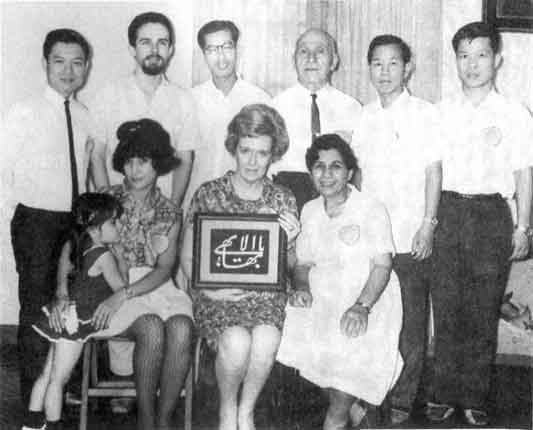 |
| (click for larger picture) |
The second National Spiritual Assembly of Taiwan, 1968. Front: Mrs. Mehri Molin, Mrs. Elizabeth Yen, Mrs. Ridvaniyyih Suleimani. Rear: Mr. Kit Yin-kiang, Mr. John Huston, Mr. Yu Hsih-ho, Mr. S.A. Suleimani, Mr. Lin Yi-mou and Mr. Huang Tsen-min.
56
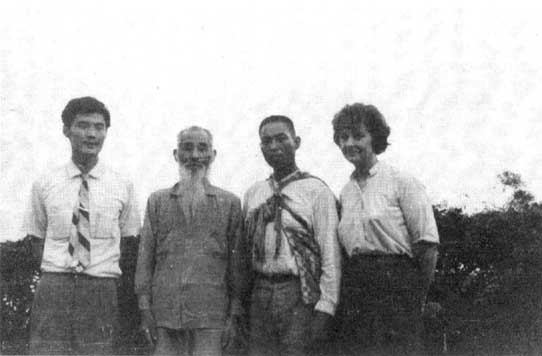
Mrs. Barbara R. Sims, secretary of the National Spiritual Assembly of North East Asia seated in Tokyo, Japan, represented that body at the first convention of the Bahá'ís of Taiwan. After the convention she and Auxiliary Board Member Mr. K. Payman visited Bahá'ís in other cities accompanied by Mr. Kuo Rong-hui (left). This photo was taken at a village near Hualien and shows one of the elders of the village and a young Bahá'í who accompanied the visitors. Mrs. Sims recalls showing her teaching album which had some Japanese explanations. Some of the villagers, especially the older ones, could not speak Mandarin Chinese but she could communicate with them in Japanese which they had learned during the Japanese occupation.
Chapter 23
23. Some Events in the Later Years
 |
| (click for larger picture) |
A Certificate of Registration of the National Spiritual Assembly of the Bahá'ís of Taiwan, issued by the government, December 8, 1970.
58
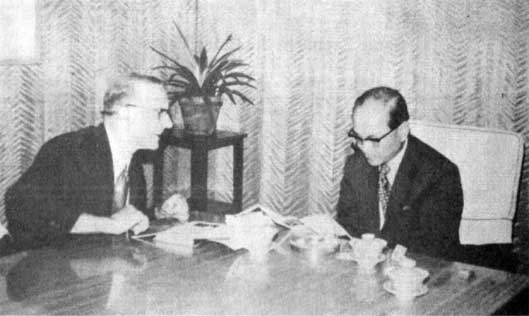
Hand of the Cause Collis Featherstone is shown presenting Bahá'í literature to Mr. Henry Kao, Mayor of Taipei, May 1972.

Mr. Suleiman A. Suleimani is shown accepting an award from His Excellency Lee Teng-Hui, the governor of Taiwan, May 28, 1982. The award honored Mr. Suleimani's "contribution to the religious welfare of the people of Taiwan". The presentation was made in a ceremony before an audience of 1,000 people. Awards were also given to representatives of several other major religions. Mr. Lee later became President of the Republic of China.
59
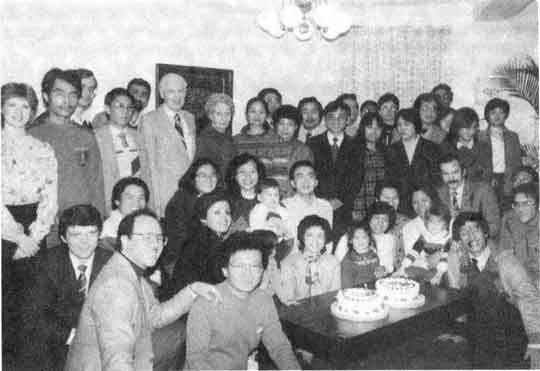 |
| (click for larger picture) |
Universal House of Justice member Mr. Hugh Chance with his wife Mrs. Margaret Chance visited Taiwan briefly in 1983, greatly encouraging the friends. They are standing in front of the picture frame. Kneeling at the right hand of Mr. Chance is Mr. David Huang who was the first Chinese appointed Counsellor for Taiwan.
60
 |
| (click for larger picture) |
Amatu'l-Bahá Rúhiyyih Khánum (in the center wearing a white veil) in Taiwan, August 1988, at an Auxiliary Board Conference. Also present were three Counsellors, Mrs. Shanta Sundrum (to the left of Rúhiyyih Khánum), Mr. Bijan Farid (top row, fifth from the left wearing glasses) and Mr. Rouhollah Mumtazi (second row second from the right).
61
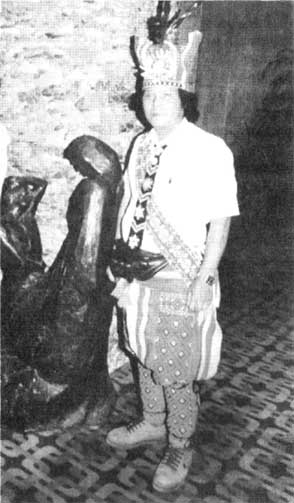
The Chief of the Beinan (Puyuma) Tribe, Mr. Chen Wen-sheng, accepted the Faith in 1990. He was the first tribal chief of an indigenous people in Taiwan (and greater China) to become a Bahá'í. His son, Mr. Chen Chien-hong, the next hereditary chief also accepted the Faith at the same time. Chief Chen is shown here in tribal dress in the Holy Land in 1992 when he attended ceremonies commemorating the one hundredth Anniversary of the Ascension of Bahá'u'lláh.
62
Names
Tsao Yun-siang
early Bahá'í in mainland China; translated several books including Bahá'u'lláh and the New Era into Chinese in the 1930s; he was never in Taiwan to our knowledge.
Chu Yao-lung (Jerome)
born on the Chinese mainland; declared in the United States in 1947; moved to Taiwan in 1949; thought to be the first resident believer in Taiwan; on the first Local Spiritual Assembly of Tainan, 1956.
Tsao Li-shih
declared in 1953 through Hand of the Cause Mr. Khádem; on the first Local Spiritual Assembly of Tainan, 1956.
Hong Li-ming (Jimmy)
declared in 1953 through Hand of the Cause Mr. Khádem; the first Taiwan-born person to become a Bahá'í; on the first Local Spiritual Assembly of Taipei, 1958.
Wong Ho-len
resided in Tsoying; declared in 1953 through Hand of the Cause Mr. Khádem.
Chien Tien-li, Cheng or Chang Tien-lee, Lee Chang
declared in the United States; moved to Taiwan in 1949; one of the first Chinese to have a Bahá'í marriage (in Denver, Colorado, U.S.A. in the middle or late 1940s).
Yuan Mien-hsien (Mason)
declared in the United States in 1947; moved to Taiwan in 1949; on the first Local Spiritual Assembly of Taipei, 1958.
Yuan Hsu-chang, Yuan Chui-chang
on the first Local Spiritual Assembly of Taipei, 1958; originally from Nanking; declared there through Mr. Chu in the late 1940s; moved to Taiwan in 1949.
Wang Tzu-nan (Gellan)
declared in United States in 1947; on the first Local Spiritual Assembly of Taipei, 1958.
63
resided in Kangshan and Taipei; declared May 1955; on the first Local Spiritual Assembly of Taipei, 1958; withdrew from the Faith several years later.
Ho Cheng-tzu, Ho Chung-tzu
resided in Chia-yi and Tainan; declared Naw-Rúz 1955; on the first Local Spiritual Assembly of Tainan, 1956; designed the Tainan Bahá'í Center.
Tu Guan-chiao (Ruthy)
the first woman to declare in Taiwan, 1955; on the first Local Spiritual Assembly of Tainan, 1956.
Wang Chi-chang
on the first Local Spiritual Assembly of Tainan, 1956.
Pai Chung-cheng, Pai Chung-chien
declared Naw-Rúz 1955; on the first Local Spiritual Assembly of Tainan, 1956.
Luk Yun-shen (Winston)
originally from Canton; declared in 1955; on the first Local Spiritual Assembly of Tainan, 1956.
Cheng Chung-chan, Cheng Chen-chang
resided in Taipei; declared Naw-Rúz 1955.
Hsiao (Siao) Tsan-chang (Johnson)
resided in Chia-yi and Taipei; declared Naw-Rúz 1955; on the first Local Spiritual Assembly of Taipei, 1958.
Tai Tung-ko
early Bahá'í of Tsoying, before 1955.
Yim Pui-foung, Yen P'ei-feng (Harry)
the first Chinese Bahá'í in Macau, 1954.
Anthony Seto [no image]
the first Chinese-American Bahá'í; he and his American wife pioneered to Hong Kong in 1954; he died in Japan in 1957 after attending the first National Convention of North East Asia.
Ni Jun-chung
became a Bahá'í in 1955; he was on the first Local Spiritual Assembly of Tainan, 1956; withdrew from the Faith some years later.
64
became a Bahá'í in Macau, 1955; translated an early prayer book into Chinese; became a Knight of Bahá'u'lláh for opening Hainan Island, 1959.
Shen Chien
resided in Chia-yi; became a Bahá'í at Summer School in 1957.
Huang Hsi
resided in Chia-yi; introduced Mr. Shen to the Faith.
Wang Pu-cheng (Pershing)
declared in 1958; on the first Local Spiritual Assembly of Taipei, 1958.
Wang P'u-sheng (Steven)
brother of Pershing Wang; first youth to enroll in Taipei, 1960.
Wu Pin-chen
the first Bahá'í in Pingtung; on the first Local Spiritual Assembly of Pingtung,
1966.
Mrs. Kao (Yang Su-su)
Yang Su-thou
Yeh Chon-ching [no image]
Mr. Yang and Miss Yeh had the first Bahá'í marriage in Taiwan, 1963.
Liu Chan-song
early Bahá'í in mainland China; translated much literature into Chinese; he was never in Taiwan to our knowledge.
Hung Bao-fung
first declared believer in Kaoshiung, 1965.
Jean Cheng, Cheng Mei Jean
a member of the Local Assembly of Tainan, 1964; she introduced Miss Hung to the Faith.
Yankee Leong
the first Chinese-Malaysian believer; first Counsellor of Chinese ancestry.
Leong Tat Chee
early Chinese-Malaysian believer; Auxiliary Board Member; with Yankee Leong travel-taught throughout the Orient.
65
early Bahá'í (1966) belonging to the Ami tribe.
Yeh Chin-hsing (Jason) [no image]
the first Bahá'í to die in Taiwan, 1965.
Mrs. Wu Ping-chen
Chung Ching-tan
Wu Wen-jen
Lee Liang-tung
Wang Ching-ian
Chiu Chung-shao
Huang Ha-tan
Wen Lung-fui
above mentioned eight names, along with Mr. Wu Ping-chen who is listed earlier, were members of the first Local Spiritual Assembly of Pingtung, 1966.
Lin Fang-nan (Mark)
resided in Hsing-Tien, enrolled in March 1965; had meetings in his house for Hand of the Cause Mr. Samandari, 1966.
Yen Chih-hsiung (Robert)
Kuo Rong-hui (Peter)
Tsao Kai-min
Wang Tseng-min, Huang Tsen-min
Huang Ting-sheng
the above five persons were elected to the first National Spiritual Assembly of Taiwan, 1967. Mr. Wang Tseng-min (Huang Tsen-min) was also on the second National Assembly, 1968.
Kit Yin-kiang, Ji Sheng-jiang
pioneer to Taiwan from Malaysia in 1967; elected to the first National Spiritual Assembly in a by-election, 1967; also on the second National Assembly, 1968.
Lin Yi-mou
delegate to the first Convention; elected to the first National Spiritual Assembly in a by-election, 1967; also elected to the second National Spiritual Assembly, 1968.
Elizabeth Yen
elected to the first National Spiritual Assembly in a by-election, 1967; also elected to the second National Assembly, 1968.
66
elected to the first National Spiritual Assembly in a by-election, 1967.
Yu (Yiu) Hsih-ho
present at the first Convention; delegate to the second and elected to the second National Spiritual Assembly, 1968.
Loren Dzen
delegate to both the first and the second Convention.
Peng (Perng) Fu-fa
present at the first Convention; delegate to the second.
Hung (Hong) Hoh-tsu
delegate to the first Convention.
Chen Ron-hsen
delegate to the second Convention.
Major Liang
delegate to the second Convention.
Kuan Ku
delegate to the second Convention.
Chen Wen-sheng
Chief of the Beinan (Puyuma) Tribe.
Chen Chien-hong
son of Chief Chen Wen-sheng; the next hereditary chief of the Beinan Tribe.
67
Afterword
The first Chinese believers in Taiwan were brought into the Faith by American Bahá'ís while studying or training in the United States during the late 1940s. However, the first pioneers to Taiwan were Iranian Bahá'ís, Mr. Suleiman A. and Mrs. Ridvaniyyih Suleimani. This devoted couple spent most of their lives serving the Chinese, on the mainland and in Taiwan.
In 1958 the American pioneers, Mr. Keith and Mrs. Edith Danielsen-Craig, arrived. They were followed in the 1960s by other Americans: Mr. Dale and Mrs. Barbara Enger, Mr. Charles Duncan, Mr. John Huston, Mr. Charles and Mrs. Wynn Bush, Mr. Henry Jarvis, Dr. Sidney and Mrs. Isabel Dean, Mrs. Abbie Maag and Mr. and Mrs. Harvey Redson. Mrs. Mehri Molin, an Iranian, played a prominent part in the 1960s. Some of the travel-teachers in those early days include Mr. Jack Davis, who in later years settled in Taiwan, Mr. Carl and Mrs. Loretta Scherer, Mr. Muhammad Labib, Mr. G.V. Tehrani, Dr. William Maxwell, Miss Tyshon Clark (Davis), Mrs. Orpha Daugherty, Dr. David and Mrs. Joy Earl, Mr. Noureddin and Mrs. Behjat Mumtazi, Mr. Rouhollah Mumtazi, Miss Agnes Alexander, Mrs. Barbara Sims and Miss Ruth Walbridge. The Malaysian Bahá'ís Mr. Yankee Leong and Mr. Leong Tat Chee visited as well, and the first Malaysian pioneer, Mr. Kit Yin-kiang, arrived in 1967 and is still at his post (1994). There were other pioneers and travel teachers through the later years.
Many years have passed since the times of which we have written. The principal figures, whether Chinese or pioneers, have, for the most part, gone.
This is mainly a chronology with photos that we could find to accompany it. The purpose of this chronicle is, of course, to preserve the past as much as possible for the future generations.
Interestingly enough, most of the research was done in the extensive files of the National Bahá'í Archives of the National Spiritual Assembly of Japan, archives which were inherited from the National Spiritual Assembly of North East Asia and some of which were collected by the compiler. Taiwan (Formosa) was under the jurisdiction of the National Spiritual Assembly of North East Asia from its formation in 1957 until 1967 when the National Spiritual Assembly of Taiwan was elected. We also spent several days going through the archives held at the Bahá'í National Office in Taipei, Taiwan, whose staff was very helpful, while other friends kindly supplied recollections and photos. The Taipei records included
68
If this chronical is devoid of assessment, critique or analysis, it is because the compiler felt she could not do more than supply a chronology with as many details as possible and as many photos as she could find that contributed to the text.
The correct transliteration of names caused problems for the compiler as did the proper Chinese written characters. Some of the latter were unrecorded, hence unavailable. Thanks to much sleuthing through files and photos and the help of the friends in Taiwan we have decided upon the proper, or most familiar, transliteration and have indentified a good number of written characters. Consequently there is a special section at the end for names. The discovery of each character represented a victory, as in those early days correspondence was carried out in English and often the Chinese involved gave themselves anglicized first names with simplified or arbitrary spellings of family names so as to make it easier for their foreign friends — albeit more difficult for historians!
We could not find photos of Hands of the Cause Mr. Kházeh or Mr. Faizi which were taken while they were in Taiwan; however, we were able to find at least one photo of all the other Hands of the Cause who visited.
Barbara R. Sims
Tokyo, Japan, 1994
69
Bibliography
- Bahá'í World Volumes XII, XV, XVII, XVIII
- Bahá'í News' of the 1950s and 1960s
- Malaysian Bahá'í News, September 1966, June 1967
- Letters, reports, documents and photographs from the National Bahá'í Archives of Japan and the National Bahá'í Archives of Taiwan; photographs from the National Bahá'í Archives of the United States; photographs from individual collections; photographs and a chronology of events sent by the Department of Library and Archival Services at the Bahá'í World Centre, Haifa.
- The Six Year Plan — Summary of Achievements (1993)
| start page |
|
|